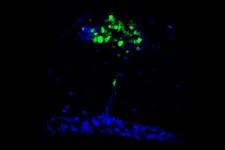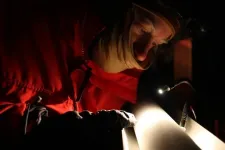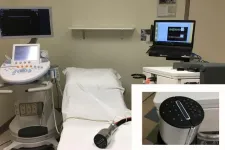(Press-News.org) The immune system is the brain's best frenemy. It protects the brain from infection and helps injured tissues heal, but it also causes autoimmune diseases and creates inflammation that drives neurodegeneration.
Two new studies in mice suggest that the double-edged nature of the relationship between the immune system and the brain may come down to the origins of the immune cells that patrol the meninges, the tissues that surround the brain and spinal cord. In complementary studies published June 3 in the journal Science, two teams of researchers at Washington University School of Medicine in St. Louis unexpectedly found that many of the immune cells in the meninges come from bone marrow in the skull and migrate to the brain through special channels without passing through the blood.
These skull-derived immune cells are peacekeepers, dedicated to maintaining a healthy status quo. It's the other immune cells, the ones that arrive from the bloodstream, that seem to be the troublemakers. They carry genetic signatures that mark them as likely to promote autoimmunity and inflammation, and they become more abundant with aging or under conditions of disease or injury. Taken together, the findings reveal a key aspect of the connection between the brain and the immune system that could inform our understanding of a wide range of brain disorders.
"There has been this gap in our knowledge that applies to almost every neurological disease: neuro-COVID, Alzheimer's disease, multiple sclerosis, brain injury, you name it," said Jonathan Kipnis, PhD, the Alan A. and Edith L. Wolff Distinguished Professor of Pathology & Immunology and a BJC Investigator. Kipnis is the senior author on one of the papers. "We knew immune cells were involved in neurological conditions, but where were they coming from? What we've found is that there's a new source that hasn't been described before for these cells."
Earlier this year, Kipnis showed that immune cells stationed in the meninges keep tabs on the brain. As part of these new studies, Kipnis and Marco Colonna, MD, the Robert Rock Belliveau, MD, Professor of Pathology and the senior author on the other paper, independently launched projects to find where such cells come from. Kipnis focused on the innate arm of the immune system and Colonna on the adaptive arm. Innate immune cells are responsible for inflammation, which helps defend against infection and heal injuries, but also can damage tissues and contribute to degenerative conditions such as Alzheimer's and Parkinson's disease. Adaptive immune cells are capable of specifically targeting undesirables such as viruses and tumors, but they also can mistakenly home in on the body's own healthy tissues, resulting in autoimmune diseases such as multiple sclerosis.
Colonna and colleagues -- including co-first authors Simone Brioschi, PhD, a postdoctoral researcher, Wei-Le Wang, PhD, a postdoctoral researcher, and Vincent Peng, a graduate student -- traced the development of B cells, antibody-producing members of the adaptive immune system. They found that most B cells in the meninges arose and matured in the skull bone marrow. As B cells mature, they must be taught to distinguish between normal proteins from the body, which pose no threat, and foreign proteins that signal infection or disease and require a response. For B cells destined for a life patrolling the boundaries of the central nervous system, the skull is a convenient site for this education.
"B cells in the bone marrow of the skull come into contact with the central nervous system and are educated by the central nervous system," said Colonna, who is also a professor of medicine. "That would not happen if they were released into the blood. Because they are directly in contact with the brain, they learn to be tolerant of brain proteins."
Along with the tolerant B cells derived from the skull, the researchers also discovered a population of B cells that come into the meninges from the blood. These blood-derived B cells are not trained to ignore normal central nervous system proteins. Some of these cells may wrongly recognize harmless central nervous system proteins as foreign and produce antibodies against them, Colonna said. Moreover, the number of these blood-derived B cells increases with age, providing a clue to why the risk of neuro-immune conditions is higher in older people.
Meanwhile, Kipnis' team -- led by co-first authors Andrea Cugurra, a graduate student, Tornike Mamuladze, MD, a visiting researcher, and Justin Rustenhoven, PhD, a postdoctoral researcher -- was searching for the source of meningeal myeloid cells, a group of innate immune cells. They found that myeloid cells arose in the bone marrow of the skull and spinal vertebrae and entered the meninges via direct channels through the bone.
Using mouse models of multiple sclerosis and of brain and spinal cord injuries, Kipnis and colleagues found that myeloid cells swarm into the brain and spinal cord in response to injury or disease. Most of the entering cells are drawn from the resident population of myeloid cells in the meninges. These are biased toward regulating and modulating the immune response. But some myeloid cells come in from the blood, and these are more inflammatory, capable of causing damage if not properly controlled.
"Understanding where these cells come from and how they behave is a critical part of understanding the basic mechanisms of neuro-immune interactions, so we can design new therapeutic approaches for neurological conditions associated with inflammation," said Kipnis, who is also a professor of neurosurgery, of neurology and of neuroscience. "The location of these cells in the skull makes them relatively accessible, and opens up the possibility of designing therapies to alter the behavior of these cells and treat neuro-immune conditions."
INFORMATION:
CORVALLIS, Ore. - A study of two methods for reconstructing ancient temperatures has given climate researchers a better understanding of just how cold it was in Antarctica during the last ice age around 20,000 years ago.
Antarctica, the coldest place on Earth today, was even colder during the last ice age. For decades, the leading science suggested ice age temperatures in Antarctica were on average about 9 degrees Celsius cooler than at present.
An international team of scientists, led by Oregon State University's Christo Buizert, has found that while parts of Antarctica were as cold as 10 degrees below current temperatures, temperatures over central East Antarctica were only 4 to 5 degrees ...
The experimental drug TEMPOL may be a promising oral antiviral treatment for COVID-19, suggests a study of cell cultures by researchers at the National Institutes of Health. TEMPOL can limit SARS-CoV-2 infection by impairing the activity of a viral enzyme called RNA replicase. The work was led by researchers at NIH's Eunice Kennedy Shriver National Institute of Child Health and Human Development (NICHD). The study appears in Science.
"We urgently need additional effective, accessible treatments for COVID-19," said Diana W. Bianchi, M.D., NICHD Director. "An oral drug that prevents SARS-CoV-2 from replicating would be an important tool for reducing the severity of the disease."
The ...
A new method to monitor epidemics like COVID-19 gives an accurate real-time estimate of the growth rate of an epidemic by carefully evaluating the relationship between the amount of viruses in infected people's bodies, called the viral load, and how fast the number of cases is increasing or decreasing.
"This new method, which effectively links what we know about how the virus grows within the body to the dynamics of how the virus spreads across a population, provides a brand new metric that public health officials, policy makers, and epidemiologists will be able to use to get up-to-date real-time information on the epidemic," said Michael Mina, assistant professor of epidemiology at Harvard T.H. Chan School of Public Health ...
HAMILTON, ON (June 3, 2021) - A novel longitudinal study on heavy drinking in young adults and the psychological impacts of COVID-19 has revealed some unexpected findings that challenge preconceived notions regarding pandemic-related alcohol use.
In a sample of nearly 500 young adults ranging in age from 18 to 25, researchers saw a reduction in problematic drinking and alcohol consequences during the initial phase of the pandemic for both men and women. This is in contrast to many anecdotal reports of increased drinking and increased household spending on alcohol during that time period.
More startling, however, were the additional findings that showed increased rates of depression and anxiety symptoms among young women - increases that ...
PORTLAND, OR - Patients with high-risk melanoma who had a course of pembrolizumab after their surgery had a longer time before their disease recurred than patients who got either ipilimumab or high-dose interferon after surgery. These findings of a large SWOG Cancer Research Network clinical trial, S1404, will be presented at the ASCO annual meeting June 6, 2021.
Researchers also measured overall survival and found no statistically significant difference in overall survival rates between the two groups of patients three and one-half years after the last patient enrolled to the trial. They did find, however, that patients taking pembrolizumab had fewer serious side effects than those treated with either high-dose interferon or ipilimumab.
The S1404 trial ...
One of the world's most endangered whale species could have added protection from threats posed by human marine activity, through technology developed by the University of East Anglia (UEA).
In partnership with the Scottish Association for Marine Science (SAMS) and the marine survey company Gardline Geosurvey Limited, UEA researchers have developed machine learning techniques that can be used to detect the presence of North Atlantic right whales by listening for the sounds they make underwater.
Detecting the animals' presence before they reach close proximity ...
When saber-toothed tigers, woolly mammoths and giant sloths roamed North America during the last Ice Age about 18,000 to 80,000 years ago, the Gulf Coast's climate was only slightly cooler, more similar to regions to the north like Missouri and North Carolina's climate today. As sea level dropped and exposed more land on the continental shelf, bald cypress trees became established in swamps in what is now the northern Gulf of Mexico.
An event occurred and suddenly killed and buried the bald cypress forests along the Gulf Coast. The buried swamp trees were preserved by sediment for thousands of years. About 18,000 years ago, sea level rose. As the ocean waters moved inland, the buried trees were preserved in their ...
HOUSTON - (June 3, 2021) - Postpartum women in bad romantic relationships are not only more likely to suffer symptoms of depression, they are also at greater long-term risk of illness or death, according to new research from Rice University, Ohio State University and the University of California, Irvine.
"Longitudinal changes in HRV across pregnancy and postpartum: Effect of negative partner relationship qualities" will appear in the July 2021 edition of Psychoneuroendocrinology. The researchers examined how relationships and partner behavior are linked to depression and heart rate variability (HRV) in women between the third trimester of pregnancy and one year postpartum.
"The quality ...
While early detection of breast cancer is critical, early prediction of how well the neoadjuvant chemotherapy treatment before surgery is working also may provide a window of opportunity when treatment could be altered and have a big impact on the patient's quality of life.
An interdisciplinary team of researchers at Washington University in St. Louis has found that combining data from tumor biomarkers, ultrasound, and ultrasound-guided diffuse optical tomography (DOT) after a patient's first cycle of pre-surgical neoadjuvant chemotherapy provided a highly accurate prediction of how the tumor was responding to the treatment. The results from a clinical trial at Washington University School of Medicine and Barnes-Jewish ...
RESEARCHERS at the University of Huddersfield have warned there is an urgent need for the country's mental health interventions to create strategies optimising the use of antidepressants after conducting a study which has highlighted an alarming rise in relation to usage and costs.
The open-access study, published by the international DARU Journal of Pharmaceutical Sciences, is entitled 'Surging trends in prescriptions and costs of antidepressants in England amid COVID-19' and has investigated the trends in prescriptions and costs of various antidepressants in England during the COVID-19 pandemic.
The researchers discovered that the total number of antidepressant prescriptions drugs dispensed during ...





